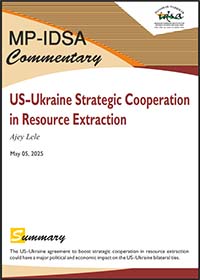US–Ukraine Strategic Cooperation in Resource Extraction
- May 05, 2025 |
- IDSA Comments
Diplomatic channels remained open for constructive deliberations even after this infamous tiff amongst the leaders. On 26 April 2025, a brief 15-minute meeting took place between Trump and Zelensky in Rome, where both leaders were attending Pope Francis’ funeral. It appears that this meeting helped both the leaders to understand each other’s point of view and make a quick progress towards improving bilateral relations.
On 1 May 2025, the US and Ukraine signed an agreement to boost strategic cooperation in resource extraction and energy independence. The two countries have agreed to establish a US–Ukraine Reconstruction Investment Fund to spur Ukraine’s economic recovery from the war with Russia.[1] The Ukrainian Parliament and the US Congress will have to approve this pact and it is expected that they will ratify it as soon as possible. Some technical issues are required to be completed before the ratification. However, it is only a matter of time that this deal will become operational. This agreement could have a major political and economic impact on the US–Ukraine bilateral ties.
Before his presidential election win, Donald Trump famously boasted that he could end the war between Russia and Ukraine in one day. But even 100 days since the Trump 2.0 administration took the oath of office, there is no end in sight for this war. Trump was of the view that Russian President Vladimir Putin should “stop shooting, sit down, and sign a deal” to end the Ukraine war.[2] While President Putin has been positive in his views when talking about peace, they do not match with his actions in the warzone. Russian drone and missile attacks on Ukraine are continuing. Kyiv is keen to have the restoration of its pre-war territorial sovereignty. However, the US is not supportive of this idea and understands that any such maximalist position would stall negotiations.
The US–Ukraine Reconstruction Investment Fund acknowledges the role of the US (both militarily and financially) in assisting Ukraine to engage with Russia. As per President Zelensky, this agreement is an equal contract,[3] while for Trump his obsession for a ‘deal’ has been met. So, this deal could be viewed as a win-win situation for both the presidents. More importantly, Trump is expected to become more proactive and his initial reluctance of not helping Ukraine would no longer be there.
For Ukraine, this deal was important for getting US military assistance. The deal expresses US solidarity with Ukraine and this should be music not only to the ears of Zelensky but also for NATO. The deal refers to the ongoing situation as a full-scale invasion by Russia. It is important to note that for Trump, this deal is both about geopolitics and geo-economics. The text of the deal notes that globally agencies which have financed or supplied equipment to the Russian war machine would not be able to join any reconstruction efforts. Obviously, the US is looking for ‘business opportunities’ in a post-war scenario.
Ukraine’s Mineral Resources
Ukraine is rich in natural resources, including rare earth metals used in consumer electronics, electric vehicles (green technologies) and various defence applications. Along with various minerals, Ukraine has deposits of RREs (rare-earth elements). Today, the global rare-earth mining market is dominated by China. Obviously, the US is keen to establish an alternate supply chain for RRE procurements. The US understands that the business of mining is a very complicated, time-consuming and capital-intensive activity.
As per the National Mining Association of the US, the process of developing a mine from initial discovery to full production takes on an average more than one decade worldwide. The entire process of development includes phases like exploration, feasibility studies, construction planning, the actual construction of a mine and making it operational. Some more years of wait is required for the business to become profitable. As per an analysis (based on data from 127 mines), mines have an average lead time of 15.7 years from discovery to commercial production, with a range of six to 32 years.[4] It costs US$ 500 million and US$ 1 billion to build a mine and separation plant.[5]
In countries with mature mining sectors, the construction and operationalisation process typically span 10 to 20 years. The most important aspect is to undertake the assessment about the economic viability of the mine before acquiring it. As per Statista, the operational life of a mine varies depending on the type of mineral. Copper mines can last anywhere from 5 to 70 years, while for substances like nickel, the average lifespans could be around 22 years.[6]
The mining sector in Ukraine was known to be reasonably well-established before the start of the present war (pre-2022). Private industry was playing an important role towards expanding this sector. Ukraine holds deposits of 22 out of 34 minerals, which the European Union (EU) considers as critical. The country has deposits of graphite, titanium, lithium, beryllium and uranium. Also, there are copper, lead, zinc, silver, nickel, cobalt and manganese deposits.[7] Pre-war Ukraine had a well-developed metallurgy industry, which is essential for large production needs. In addition, they had an educated labour force available in good numbers. There was a public–private partnership (PPP) model in place and the sector was growing.
Ukraine was seeking international investments in this sector to realise its full potential. Along with this, there was a developed transport infrastructure in place catering for the European and Asian markets. Private enterprises like Interpipe Group, ArcelorMittal, Industrial Union of Donbas, Metinvest and few others were involved in the mining business.[8] It is expected that the US must have taken into consideration this available infrastructure (whatever form it may be today) before finalising the deal.
Challenges for the US
If the US aims to reshape the global critical minerals landscape through investments in Ukraine, then it must overcome significant geopolitical challenges. The main challenge which the US is likely to face is access to the mineral resources, particularly in eastern regions such as Luhansk, Donetsk, Zaporizhzhia and Dnipropetrovsk.[9] These areas are heavily affected by Russian occupation. The Donbas region, which has minimal Ukrainian influence, is particularly important due to its wealth of coal and minerals vital for modern industry.
Economically, it is also going to be a challenging task for the US to start earning profits soon. The proposed fund will be filled with income exclusively from new licenses. The fund would be “jointly managed” by the US and Ukraine. All profits generated would be reinvested in Ukraine in the first decade.[10] Under this deal, Ukraine is expected to contribute 50 per cent of the revenue from its state-owned resources to a joint fund. However, it is unclear from where the remaining 50 per cent will come from.
The bigger concern is whether Ukraine as a state can stabilise and quickly grow its economy after the war, specifically without firm security guarantees on offer from the US. It would be difficult to predict how rapidly Ukraine can recover and meet the financial commitments of this deal in a post-war scenario. Reports note that the US has provided around US$ 175 billion to Ukraine.[11] While President Trump has publicly talked about the prospects of recovering the support that the US has provided to Ukraine, it may take a few decades or more for the US to recover this amount of money from Ukraine’s mining industry.
The latest deal with Ukraine obviously looks beyond an economic cost-benefit analysis. There are broader geopolitical considerations at stake. The signing of the deal indicates that there is a realisation within the US administration that they cannot afford to dump Ukraine, especially given that the enduring power dynamics between the West and Russia are unlikely to change significantly anytime soon.
Views expressed are of the author and do not necessarily reflect the views of the Manohar Parrikar IDSA or of the Government of India.
[1] “Treasury Announces Agreement to Establish United States-Ukraine Reconstruction Investment Fund”, U.S. Department of the Treasury, 30 April 2025.
[2] “Trump Urges Putin to ‘Stop Shooting, Sit Down and Sign a Deal’ to End Ukraine War”, The Kyiv Independent, 28 April 2025.
[3] “Zelensky Says Minerals Deal With U.S. ‘Truly Equal’”, The Moscow Times, 2 May 2025.
[4] “Discovery to Production Averages 15.7 years for 127 Mines”, S&P Global, 6 June 2023.
[5] “Breaking Down the U.S.-Ukraine Minerals Deal”, Center for Strategic & International Studies, 27 February 2025.
[6] “Mine Lifespan by Selected Commodities”, Statista, 19 March 2013.
[7] “What Minerals Does Ukraine Have and What Are They Used For?”, BBC, 30 April 2025.
[8] “The Mineral Industry of Ukraine”, 2020–2021 Minerals Yearbook—Ukraine (Advance Release), US Geological Survey, February 2025.
[9] “Mapping Ukraine’s Rare Earth and Critical Minerals”, Al Jazeera, 28 February 2025.
[10] “All About the US-Ukraine Agreement on Ukrainian Minerals, Reconstruction”, The Indian Express, 2 May 2025.
[11] “Here’s How Much Aid the United States Has Sent Ukraine”, Council on Foreign Relations, 11 March 2025.






